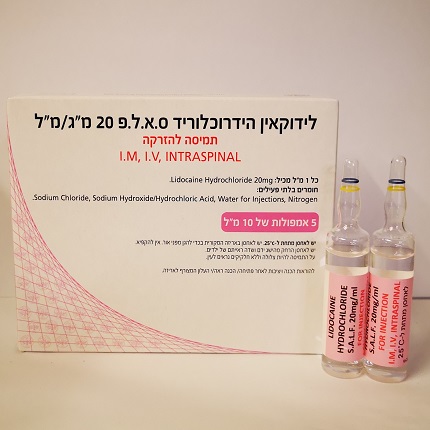Quest for the right Drug

לידוקאין הידרוכלוריד ס.א.ל.פ 20 מ"ג/מ"ל LIDOCAINE HYDROCHLORIDE S.A.L.F. 20 MG/ML (LIDOCAINE HYDROCHLORIDE)
תרופה במרשם
תרופה בסל
נרקוטיקה
ציטוטוקסיקה
צורת מתן:
תוך-שרירי, תוך-ורידי, תוך-עורי, תת-עורי, הזרקה תת-רירית, לסביבת העצב, אפידורל, שדרתי, : I.M, I.V, INTRADERMAL, S.C, SUBMUCOSAL, PERINEURAL, EPIDURAL, SPINAL, I.V REGIONAL ANAESTHESIA
צורת מינון:
תמיסה להזרקה : SOLUTION FOR INJECTION
עלון לרופא
מינוניםPosology התוויות
Indications תופעות לוואי
Adverse reactions התוויות נגד
Contraindications אינטראקציות
Interactions מינון יתר
Overdose הריון/הנקה
Pregnancy & Lactation אוכלוסיות מיוחדות
Special populations תכונות פרמקולוגיות
Pharmacological properties מידע רוקחי
Pharmaceutical particulars אזהרת שימוש
Special Warning עלון לרופא
Physicians Leaflet
Posology : מינונים
4.2 Posology and method of administration Other special patient groups Posology • Doses should be reduced in patients in poor general Local and regional anaesthesia. condition or in those with reduced protein binding As a matter of principle the smallest possible dose that capacity (resulting e.g. from renal insufficiency, liver produces adequate anaesthesia should be administered. insufficiency, cancer, pregnancy). The dosage should be adjusted individually according to • In patients with severe renal insufficiency the dose the particulars of each case. may need to be adapted due to reduced clearance and increased half-life of lidocaine (see section 5.2). Patients Adults: with liver diseases show reduced tolerance towards When injected into tissues with marked systemic amide-type local anaesthetics. This may be due to absorption, without combination with a vasoconstrictor, a reduced hepatic metabolism and decreased protein single dose of lidocaine Hydrochloride monohydrate synthesis resulting in a lower protein binding rate of the should not exceed 4.5 mg/kg body weight (BW) (or 300 local anaesthetic. Dose reduction is advisable in such mg). If combined with a vasoconstrictor, 7 mg/kg BW (or cases. 500 mg) of lidocaine Hydrochloride monohydrate per • The dose should be reduced in patients showing clinical single dose should not be exceeded. signs of cardiac insufficiency. Nevertheless, local or regional nerve blockage can be the anaesthetic method For the clinical uses listed below, recommendations for of choice in such patients. single doses and strengths of the injection solution to be • During pregnancy, the dose may need to be reduced administered to adults with average body weight (70 kg) depending on the type of anaesthesia. Regional are as follows: anaesthetic blocks in which usually large doses are Usual Type of Concentration volume Maximum dose [mg] required should be avoided during the first trimester. anaesthesia [%] For use in anaesthetic blocks in which smaller doses are [ml] 300 administered, the dosage may need to be reduced Infiltration 0.5-1 because of the altered anatomical and physiological 500 (with epinephrine) Major nerve blocks 1-2 30-50 500 (with epinephrine) characteristics in late pregnancy. Minor nerve blocks 1 5-20 200 Antiarrhythmic therapy Epidural 1-2 15-30* 500 (with epinephrine) Adults Spinal 1.5 or 5 in 1-2 100 The dosage must be adjusted according to individual 7.5% glucose requirements and the therapeutic effect. Intravenous regional anaesthesia (IVRA) 0.5 40 - upper limb 0.25 50-100 Bolus: -lower limb Usual loading doses are 50 - 100 mg or 1 - 1.5 mg/kg *1.5 ml per segment in average BW of lidocaine Hydrochloride monohydrate as direct intravenous injection, corresponding to approximately 2.5 - 5 ml or 0.05 ‑ 0.075 ml/kg BW of LIDOCAINE monitored for toxic effects caused by accumulation of HYDROCHLORIDE S.A.L.F. 20 mg/ml. The rate of active metabolites. injection should not exceed 25-50 mg/min, corresponding to approximately 1.25 – 2.5 ml/min In cases of severe renal insufficiency the dose may LIDOCAINE HYDROCHLORIDE S.A.L.F. 20 mg/ml. need to be adapted (see also section 5.2). If the therapeutic effect of the first dose is insufficient within the first 5 – 10 minutes, the initial dose may be Method of administration repeated once or twice up to a maximum dose of Local and regional anaesthesia 200 - 300 mg in 1 hour. Intradermal, intramuscular, subcutaneous, or submucosal use (infiltration), perineural (injection into Maintenance: the surroundings of peripheral nerves), epidural or To maintain therapeutic plasma lidocaine concentrations spinal use. (1.5 ‑ 5 microgram/ml), lidocaine Hydrochloride Intravenous use regarding intravenous regional monohydrate is infused at a rate of 20 ‑ 50 microgram/kg anaesthesia (Bier`s block). BW/min (about 1-4 mg/min), corresponding to Every local anaesthetic procedure should only be approximately 0.001 – 0.0025 ml/kg BW/min. carried out by personnel adequately skilled in the Infusions can be prepared by adding 1000 mg of respective anaesthetic technique. lidocaine Hydrochloride monohydrate, corresponding to 50 ml LIDOCAINE HYDROCHLORIDE S.A.L.F. Antiarrhythmic therapy 20 mg/ml, to 500 ml of glucose 5% solution or Intravenous use physiological saline. Administer as slow intravenous injection or intravenous The infusion should be terminated as soon as the infusion after dilution in a suitable vehicle solution. patient's basic cardiac rhythm appears to be stable or Because of the relatively short duration of action of at the earliest signs of toxicity. It should rarely be lidocaine, the injection should be followed by necessary to continue the infusion beyond 24 hours. continuous infusion, if possible, using an infusion As soon as possible, patients should be changed to an pump. oral antiarrhythmic agent for maintenance therapy.

שימוש לפי פנקס קופ''ח כללית 1994
לא צוין
תאריך הכללה מקורי בסל
01/01/1995
הגבלות
תרופה שאושרה לשימוש כללי בקופ'ח
מידע נוסף
עלון מידע לצרכן
20.08.24 - החמרה לעלוןלתרופה במאגר משרד הבריאות
לידוקאין הידרוכלוריד ס.א.ל.פ 20 מ"ג/מ"ל